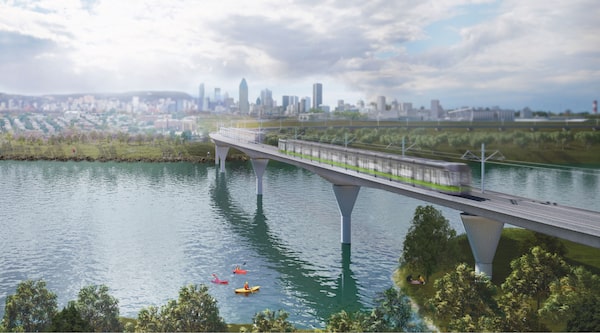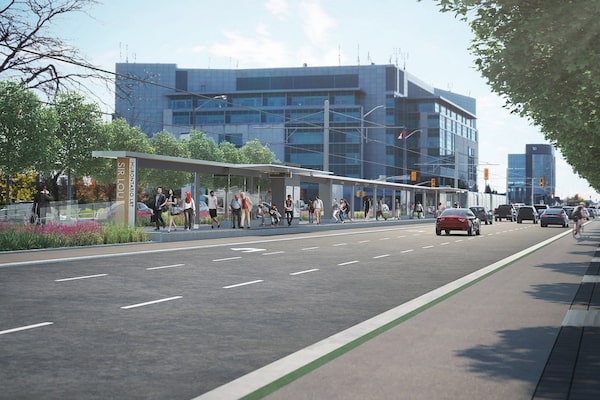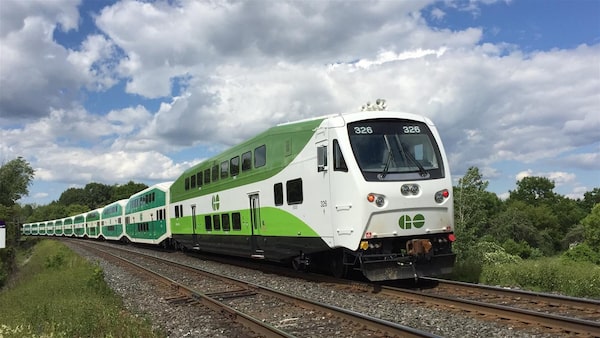
The impending Réseau Express Métropolitain is stimulating development around stations across Greater Montreal.Caisse de dépôt et placement du Québec/Supplied
From the window-lined third floor of Solar Uniquartier’s first completed office tower, it looks as though anyone living, working, dining or shopping in the $1.3-billion development will have to sprint across four lanes of highway traffic to reach the Du Quartier light-rail transit station.
Thank goodness for finishing touches. Soon after the 2017 announcement of Greater Montreal’s Réseau express métropolitain (REM) rapid-transit system, Solar Uniquartier’s developer, Devimco Immobilier, modified its plans to include a direct pedestrian link to the nearby station. The pedestrian link is scheduled to open in 2021. By that time, Solar Uniquartier will be home to 2,600 housing units and 1.2-million-square-feet of commercial and office space.
The addition of a pedestrian bridge wasn’t the only change prompted by REM’s green-light to build another 67-kilometre of light-rail transit – making it the world’s fourth-longest automated transportation system.
Transit fuels development outside of a city’s urban core
“When we bought the land in 2013, we didn’t have a firm answer about REM,” says Marco Fontaine, Devimco’s vice-president of residential building development. “We took a risk, and as soon as the line was confirmed, the tempo and scale of everything changed because demand took off.”
The spike in demand was especially pronounced among commercial buyers and tenants, says Mathieu Bordeleau, Devimco’s vice-president of development and operations. “KPMG has already leased about 11,000-square feet for a satellite office. This kind of tenant wants to be in a well-connected environment that's fun and exciting, like downtown Montreal, but also doesn’t need all its employees to commute downtown. It’s about employee retention, and for some companies, it’s also about paying lower rents.”

Recent transit-oriented developments, such as Montreal's REM, aim to bring the dual benefits of consistent use and economic development outside of city centres.Caisse de dépôt et placement du Québec/Supplied
Those are two of many interconnected factors fuelling a commercial development boom around impending transit infrastructure such as the $6.3-billion REM, the Greater Toronto Area’s $1.4-billion Hurontario LRT, and the recent extension of weekday GO train service into the Niagara region. Rather than shuttling commuters between bedroom communities and downtown offices, the latest transit-oriented developments, or TODs, are focusing on the dual benefits of consistent transit use and economic development outside major city centres.
TODs have been important aspects of Canadian urban planning for decades, with developments along Toronto’s Yonge subway line and around Vancouver’s False Creek being two prominent examples. But because TODs have rarely extended into the suburbs, and have tended to be mostly residential, they have done little to change the unidirectional commuter transit flows of North America’s major metropolitan areas.
Planners are adapting to transit demand
“Transit planners are realizing that the old ways don't work,” says Ahmed El-Geneidy, a professor at McGill University’s School of Urban Planning. “If we want to spend billions of dollars on light-rail infrastructure, we need to have people going in both directions throughout the day. And the only way to do that is to have businesses, office space and employment opportunities not just in city centres, but in and around stations all along transit lines.”
Many European planners have successfully developed suburban transit hubs that are attractive places to both live and work, Dr. El-Geneidy says, pointing to high-tech meeting spaces dubbed “Seats2meet” that are available to rent in Dutch stations. “Office space located in or near these nodes attracts many different kinds of businesses, from branch offices to startups to the shared workspaces that are popular with the younger generation.”

The impending Hurontario LRT is helping Mississauga work toward the goals of its Downtown21 Master Plan, spurring development around the Square One Shopping Centre.Courtesy of Infrastructure Ontario/Supplied
While Canada “has not pushed commercial TOD enough,” according to Dr. El-Geneidy, progress is being made where major transit expansions are now under way. Mississauga’s Downtown21 Master Plan, for instance, aims to boost office space from 3.6-million square feet to 17-million square feet over the next eight to 10 years in the area around the gigantic Square One Shopping Centre.
One of the new developments in the thick of the planning overhaul, Camrost Felcorp’s three-acre Exchange District, is proposing to combine more than 2,000 condo units with approximately 100,000-square feet of retail and office space, all of which will be seamlessly connected to the Hurontario LRT.
“The presence of the LRT and other forms of public transit means we don’t need as much parking," says Joseph Feldman, Camrost’s director of development. "This allows us to bury the parking underground and create a pedestrian realm at ground level, with commercial, retail and office space in a podium, and residential on top.”

Mixed-use development around transit corridors helps create bidirectional travel throughtout the day, instead of merely unidirectional commuter usage.Solmar Development Corporation/Supplied
Leasing or buying office space in the Exchange District will “certainly be at a discount compared to downtown Toronto,” he adds. “I think it's the best investment in the GTA right now because of the future potential and upside transit will bring.”
The mixed-use project isn’t necessarily designed to allow residents to live and work in the same venue, Mr. Feldman says. Rather, “it’s about putting people on the ground at all times of the day, instead of always leaving in the morning and coming home in the evening. Our goal is to have a constant flow.”
Partnerships emerge as planners and developers follow transit
Sound familiar? With developers and transit planners sharing this goal, innovative partnerships are taking shape. To fund the REM’s construction, for instance, the Caisse de dépôt et placement du Québec is phasing in a royalty fee of $10 per square foot for all new building permits granted within one kilometre of stations. In effect, this means Devimco Immoblier is paying more than $30-million for Solar Uniquartier’s nearby REM station.
Then there’s the new GO train station in Grimsby, Ont., which is partly funded by real estate developers with assets in the area. Slated to open in 2021, as GO Transit’s new Niagara service expands, the station’s official announcement caused an “immediate surge” in developer and investor interest, says Rino Mostacci, the Niagara Region’s commissioner of planning and development services. New projects around the station include the Casablanca Corporate Centre, a five-storey building with 60,000 square feet of office space being developed by Homes By DeSantis and Rosart Properties.

GO Transit’s new Niagara train service has brought a surge of developer and investor interest to the region.Courtesy of the City of Niagara Falls/Supplied
This and other projects “would not have happened without the GO announcement,” Mr. Mostacci adds. “From an investor perspective, the risk becomes much lower once a commitment has been made to reliable transit.”
This commitment also benefits Grimsby’s economy. “We weren’t just looking at getting people into Toronto,” says Diana Morreale, the Niagara Region’s director of development approvals. “These transit stations benefit local employers because they’re a good way to get employees into Niagara. They locate their business here, they bring their employees here and they contribute to our local economy.”